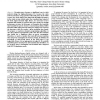Free Online Productivity Tools
i2Speak
i2Symbol
i2OCR
iTex2Img
iWeb2Print
iWeb2Shot
i2Type
iPdf2Split
iPdf2Merge
i2Bopomofo
i2Arabic
i2Style
i2Image
i2PDF
iLatex2Rtf
Sci2ools
ISCAS
2005
IEEE
2005
IEEE
Transition time bounded low-power clock tree construction
— Recently power becomes a significant issue in clock network design for high-performance ICs because the clock network consumes a large portion of the total power in the whole system. Also, clock signal is the signal with the highest frequency in the whole system, which makes the transition time bound of the clock signal extremely tight. Hence, it is necessary to have transition time bounds to construct low-power clock trees in high performance systems. In this paper, we formulate the transition time bounded low-power clock tree construction problem. Buffer insertion, buffer sizing and wire sizing are employed to construct the low-power clock tree under a given transition time bound. We propose a top-down dynamic programming algorithm to solve the problem. Experimental results show that the transition time bound has a significant effect on power consumption. Therefore, we need to consider the trade-off between transition time and power consumption in clock tree design. In addition, ...
Related Content
| Added | 25 Jun 2010 |
| Updated | 25 Jun 2010 |
| Type | Conference |
| Year | 2005 |
| Where | ISCAS |
| Authors | Min Pan, Chris C. N. Chu, J. Morris Chang |
Comments (0)

